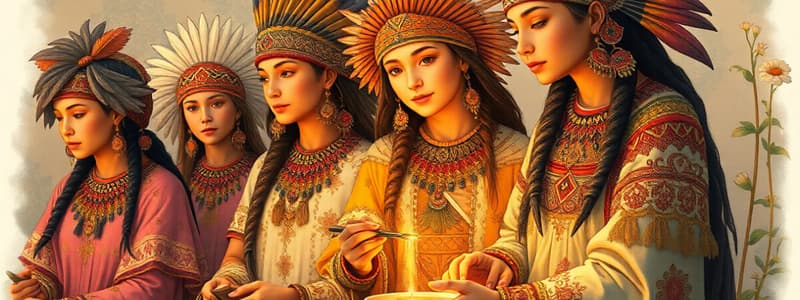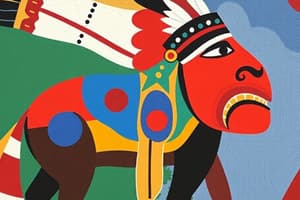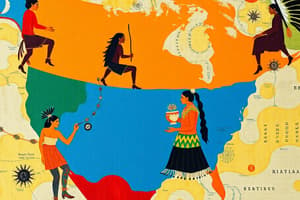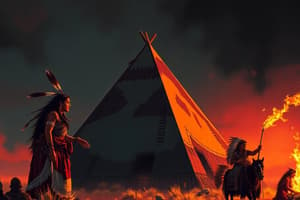Podcast
Questions and Answers
How did the first peoples likely arrive in North America?
How did the first peoples likely arrive in North America?
- By crossing a bridge from Europe
- By migrating southward over a land bridge from Siberia (correct)
- By walking across an ice sheet
- By sailing directly from Asia to North America
What was a significant characteristic of the Mississippian culture?
What was a significant characteristic of the Mississippian culture?
- They constructed fortified cities (correct)
- They lived in small, temporary shelters
- They primarily relied on fishing for sustenance
- They were nomadic and moved frequently
Which two confederacies included Iroquoian-speaking groups?
Which two confederacies included Iroquoian-speaking groups?
- Algonquian Confederacy and Five Nations Confederacy
- Five Nations Confederacy and Huron Confederacy (correct)
- Huron Confederacy and Plains Confederacy
- Mississippian Confederacy and Woodland Confederacy
What was the demographic estimate of Indigenous people before European contact?
What was the demographic estimate of Indigenous people before European contact?
What type of agriculture did the Great Lakes Farmers primarily practice?
What type of agriculture did the Great Lakes Farmers primarily practice?
Which group primarily utilized fishing as part of their subsistence?
Which group primarily utilized fishing as part of their subsistence?
What was the typical family structure in Great Lakes villages?
What was the typical family structure in Great Lakes villages?
What were common motives for warfare among the Great Lakes peoples?
What were common motives for warfare among the Great Lakes peoples?
Which language group does NOT belong to the Indigenous languages mentioned?
Which language group does NOT belong to the Indigenous languages mentioned?
What was the role of women in Great Lakes Indigenous societies?
What was the role of women in Great Lakes Indigenous societies?
Which statement best describes the role of women in woodland/subarctic societies?
Which statement best describes the role of women in woodland/subarctic societies?
What was a shared practice among woodland/subarctic groups during times of need?
What was a shared practice among woodland/subarctic groups during times of need?
What was the primary method of leadership among woodland/subarctic peoples?
What was the primary method of leadership among woodland/subarctic peoples?
Which of the following best describes the political structure of woodland/subarctic groups?
Which of the following best describes the political structure of woodland/subarctic groups?
What was a common practice among Plains tribes regarding social structure?
What was a common practice among Plains tribes regarding social structure?
How did the arrival of horses impact the role of women among Plains peoples?
How did the arrival of horses impact the role of women among Plains peoples?
What was the primary source of food and materials for Plains hunters?
What was the primary source of food and materials for Plains hunters?
In what context could woodland/subarctic women act as shamans?
In what context could woodland/subarctic women act as shamans?
What was the role of women in harvesting and preparing resources?
What was the role of women in harvesting and preparing resources?
What role did women play during the Sun Dance among the Siksika tribe?
What role did women play during the Sun Dance among the Siksika tribe?
What impact did increased male casualties from mounted warfare have on Siksika societal structure?
What impact did increased male casualties from mounted warfare have on Siksika societal structure?
Which social classes existed among the West-coast fishers?
Which social classes existed among the West-coast fishers?
How did lineage differ between the northern and southern groups of Indigenous peoples?
How did lineage differ between the northern and southern groups of Indigenous peoples?
What was a key economic reliance of the Inuit in the Arctic region?
What was a key economic reliance of the Inuit in the Arctic region?
What role did women have in the Haida society?
What role did women have in the Haida society?
What was the purpose of the potlatch ceremony among the West-coast peoples?
What was the purpose of the potlatch ceremony among the West-coast peoples?
Which statement correctly describes the relationship between spirituality and nature for Indigenous people?
Which statement correctly describes the relationship between spirituality and nature for Indigenous people?
What was the common characteristic of leadership in Inuit summer villages?
What was the common characteristic of leadership in Inuit summer villages?
How were marriages typically arranged among the Haida?
How were marriages typically arranged among the Haida?
Which group had the most established hierarchy in terms of social structure?
Which group had the most established hierarchy in terms of social structure?
Flashcards
What is a Potlatch?
What is a Potlatch?
A complex ceremony used by Indigenous peoples of the West Coast. It could be used for various purposes, such as celebrating a new chief or mourning the dead.
Who are the Inuit?
Who are the Inuit?
The Indigenous peoples of the Far North who were known for their skilled hunting and fishing techniques, as well as their reliance on kayaks and dog sleds.
Describe the leadership structure of the Inuit.
Describe the leadership structure of the Inuit.
Inuit society was characterized by informal and temporary leadership, with village leaders emerging in the summer during whaling season.
How did Indigenous people view the environment?
How did Indigenous people view the environment?
Signup and view all the flashcards
What is the significance of Potlatch ceremonies?
What is the significance of Potlatch ceremonies?
Signup and view all the flashcards
What is the concept of animism?
What is the concept of animism?
Signup and view all the flashcards
What is matrilineal inheritance?
What is matrilineal inheritance?
Signup and view all the flashcards
What is patrilineal inheritance?
What is patrilineal inheritance?
Signup and view all the flashcards
Describe the social hierarchy among the Siksika.
Describe the social hierarchy among the Siksika.
Signup and view all the flashcards
What is polygamy?
What is polygamy?
Signup and view all the flashcards
How did First Peoples arrive in North America?
How did First Peoples arrive in North America?
Signup and view all the flashcards
Who were the Mound Builders?
Who were the Mound Builders?
Signup and view all the flashcards
What was the Hopewell culture?
What was the Hopewell culture?
Signup and view all the flashcards
What was the Mississippian culture?
What was the Mississippian culture?
Signup and view all the flashcards
How did agriculture affect the indigenous peoples of Canada?
How did agriculture affect the indigenous peoples of Canada?
Signup and view all the flashcards
Who were the Huron Confederacy?
Who were the Huron Confederacy?
Signup and view all the flashcards
Who were the Five Nations Confederacy?
Who were the Five Nations Confederacy?
Signup and view all the flashcards
What is slash-and-burn agriculture?
What is slash-and-burn agriculture?
Signup and view all the flashcards
What was the role of women in the Great Lakes cultures?
What was the role of women in the Great Lakes cultures?
Signup and view all the flashcards
How was trade important for the Great Lakes cultures?
How was trade important for the Great Lakes cultures?
Signup and view all the flashcards
Women's Role in Woodland/Subarctic Societies
Women's Role in Woodland/Subarctic Societies
Signup and view all the flashcards
Women's Political Influence in Woodland/Subarctic Societies
Women's Political Influence in Woodland/Subarctic Societies
Signup and view all the flashcards
Linguistic Diversity of Woodland/Subarctic Peoples
Linguistic Diversity of Woodland/Subarctic Peoples
Signup and view all the flashcards
Seasonal Movement of Woodland/Subarctic Peoples
Seasonal Movement of Woodland/Subarctic Peoples
Signup and view all the flashcards
Informal Leadership in Woodland/Subarctic Societies
Informal Leadership in Woodland/Subarctic Societies
Signup and view all the flashcards
Collective Decision-Making in Woodland/Subarctic Societies
Collective Decision-Making in Woodland/Subarctic Societies
Signup and view all the flashcards
Sharing and Cooperation in Woodland/Subarctic Societies
Sharing and Cooperation in Woodland/Subarctic Societies
Signup and view all the flashcards
Buffalo Hunting and the Role of Women
Buffalo Hunting and the Role of Women
Signup and view all the flashcards
Plains Buffalo Hunting Tribes
Plains Buffalo Hunting Tribes
Signup and view all the flashcards
Buffalo's Importance to Plains Societies
Buffalo's Importance to Plains Societies
Signup and view all the flashcards
Study Notes
Indigenous Peoples Before European Arrival
- Arrived from Asia at least 14,000 years ago, likely crossing a land bridge between Siberia and North America. Migrated south via an ice-free corridor.
- Some may have travelled south along the west coast, or arrived by boat.
- Arrival occurred in waves, not all at once.
Mound Builders (Central/Eastern U.S.)
- Hopewell culture (1st - 500 AD), spread into Ontario. Pottery influenced by Hopewell culture was found in Alberta.
- Mississippian culture (700-1400 AD) built fortified cities.
- Farming techniques of Hopewell and Mississippian cultures spread to Central Canada. Corn cultivation reached Ontario by 500 AD.
Pre-Contact Demographics
- Approximately 500,000 people.
- At least 50 languages belonging to 10 language groups (Algonquian, Iroquoian, Siouan, Dene, Eskimo-Aleut, Kootenayan, Salishan, Wakashan, Tsimshian, Haida).
- Classified into 5 main Indigenous groups based on subsistence.
Great Lakes Farmers
- Iroquois-speaking. Relied heavily on agriculture for food.
- Included the Huron Confederacy and Five Nations Confederacy.
- Huron Confederacy (30,000 people) lived in the Georgian Bay, Ontario area, consisting of 4 nations.
- Five Nations Confederacy (16,000 people) consisted of 5, later 6, nations.
- Economy, organization, warfare, based on slash-and-burn agriculture.
- Lived in semi-permanent villages.
Woodland/Subarctic Hunters, Fishers, Gatherers
- Primarily Algonquian and Dene/Athapaskan speaking groups (e.g. Micmac, Montagnais, Algonquins, Ojibwas, Cree).
- Followed seasonal movements for hunting.
- Lived in small family groups in winter and larger groups for fishing and gathering in summer.
- No formal political structure like the Huron or Iroquois.
- Leadership informal. Winter band leaders were usually skilled hunters, while summer bands had chiefs.
- Decision-making was collective and based on persuasion. Shared hunting territory as needed.
Plains Buffalo Hunters
- Included nations of the Blackfoot Confederacy (Piikani, Kainai, Siksika, Tsuu T'ina).
- Obtained food, clothing, shelter and tools from buffalo.
- Followed seasonal movements.
- Main social units were tribes, made up of bands.
- Tribes were fairly independent, but gathered for ceremonies. Societies like military societies unified tribes.
West Coast Fishers
- Three social classes: nobles, commoners, slaves.
- Lineage traced through maternal lines in the north, and paternal in the south.
- No political units beyond individual villages.
- Women had roles in Haida society, active as traders and with property rights being traced through the female line.
- Haida marriages were arranged by the bride's father and uncle.
Arctic Hunters
- Far north was uninhabited until 4,000 years ago.
- Early migrants included Thule (ancestors of Inuit).
- Fished for char, and hunted sea and land animals.
- Used kayaks in summer and dog sleds in winter.
- Lived in small family groups.
- Informality in leadership, with summer village leaders overseeing whale crews.
Gender Roles/Power (Great Lakes)
- Men: Hunted, fished, built houses, cleared land, waged war, held political offices.
- Women: Controlled households, did most farming, controlled property (inherited through female lines), significant influence over leaders, deposed chiefs if needed, yet were not on village councils.
West-coast Economy and Culture
- Relied on sea animals, esp. salmon, as a primary food source.
- Used cedar and fir to build boats, totem poles, and houses.
- Potlatch ceremonies were used for new chiefs, mourning, and confirming status.
Indigenous Religion (General)
- Saw no distinction between humans and the environment.
- Believed animals and objects had spirits that needed respect.
- Many attempted to access spirit worlds through vision quests, shamans, or religious societies.
Studying That Suits You
Use AI to generate personalized quizzes and flashcards to suit your learning preferences.
Related Documents
Description
Explore the rich history and cultures of Indigenous peoples in North America prior to European contact. This quiz covers major groups, migration patterns, and agricultural practices, including the Mound Builders and the Great Lakes Farmers. Test your knowledge on demographics and languages among these diverse groups.



